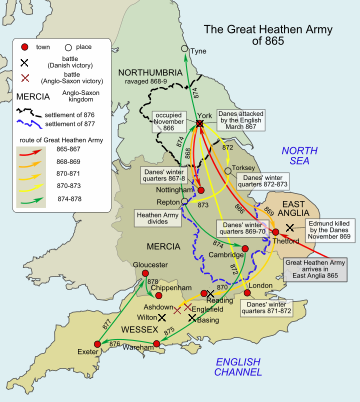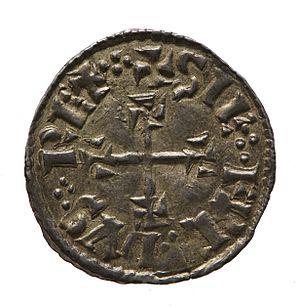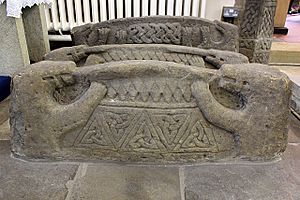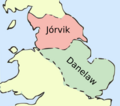Scandinavian York facts for kids
Quick facts for kids
Scandinavian York
|
|||||||||
|---|---|---|---|---|---|---|---|---|---|
| Kingdom of Jórvík: 865–954 Earldom: 954–1066 |
|||||||||
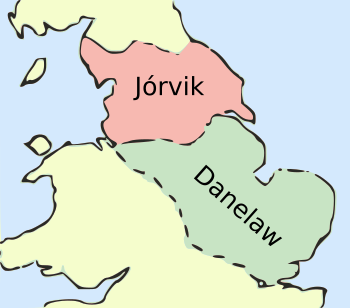 |
|||||||||
| Status | The kingdom of York, forming the southern part of Northumbria, and to the south of it the rest of the Danelaw | ||||||||
| Common languages | Old Norse • Old English | ||||||||
| Religion |
|
||||||||
| Government | Monarchy Earldom (after 954) |
||||||||
| King Earl (after 954) |
|||||||||
| History | |||||||||
|
• Formed
|
867 | ||||||||
| 1066 | |||||||||
| Currency | Sceat (peninga) | ||||||||
|
|||||||||
| Today part of | United Kingdom | ||||||||
Scandinavian York or Viking York (Old Norse: Jórvík) was a powerful Viking kingdom in what is now Yorkshire, England. It existed from the late 800s until it became part of England after the Norman Conquest in 1066. The city of York was its main center. This Viking kingdom was also closely connected to the Kingdom of Dublin in Ireland.
Contents
- Discovering Viking York's History
- York Before the Vikings Arrived
- The Great Viking Invasion
- Viking Rule in York (866–901)
- West Saxon Rule in Northumbria
- Vikings Return to Power (903–926)
- English Rule (927–939)
- Vikings Take Back Control (939–944)
- English Rule Again (944–947)
- Vikings Return One Last Time (947–954)
- The End of Viking Kings: The Earldom of York (954–1066)
- Life and Trade in Viking York
- Lasting Impact of Viking York
- Images for kids
- See also
Discovering Viking York's History
York Before the Vikings Arrived
The city of York has a very long history. The Romans called it Eburacum and made it an important capital city. They built strong walls and a fortress there. Around 407 AD, the Romans left Britain.
Later, in the early 600s, Anglo-Saxons took over the settlement. It became known as Eoforwic and was a busy trading port. The Anglo-Saxon king Edwin of Northumbria was baptized there in 627.
The Great Viking Invasion
Vikings had been raiding England's coasts since the late 700s. But in 865, a huge Viking army landed. They came to conquer, not just to raid. This army was called the "mycel heathen here" (Great Heathen Army) in the Anglo-Saxon Chronicle.
They first landed in East Anglia. The local people made peace with them and gave them horses. The army, led by Ivar the Boneless and his brother Halfdan Ragnarsson, then moved north.
Vikings Capture York
In Northumbria, the Anglo-Saxons were fighting among themselves. Ivar the Boneless used this to his advantage. He captured York in 866 or 867. The two Anglo-Saxon leaders then joined forces to try and take back the city.
They attacked the Vikings, who hid behind the old Roman walls. In the battle on March 21, 867, both Anglo-Saxon leaders were killed. The Northumbrians were defeated.
Viking Rule in York (866–901)
After the battle, the remaining Northumbrian leaders made peace with the Vikings. The Vikings put a local prince, Ecgberht, in charge as a puppet ruler. This meant he ruled, but the Vikings were in control.
In 872, the Northumbrians tried to rebel when the main Viking army was away. But the Vikings quickly regained control of York in 873.
Halfdan Becomes King
In 875 or 876, Halfdan Ragnarsson returned to York. He became the first Viking king of southern Northumbria, which was then called the Kingdom of York (Jórvík). The Anglo-Saxon Chronicle says Halfdan "apportioned the lands of North-humbria: and they thenceforth continued ploughing and tilling them." This means he divided the land among his followers.
Halfdan's rule was short. He was killed in 877 while trying to claim the Kingdom of Dublin.
Early Viking Kings
After Halfdan, there was a period without a clear king. Then, Guthred became king in 883. He was the first Christian Viking king of York. Churches in Northumbria had been raided by Vikings. However, York's cathedral remained an important religious center. Guthred died in 895 and was buried at York Minster.
Siefredus of Northumbria took over after Guthred. We know about him mostly from coins. A large collection of coins, called the Cuerdale Hoard, was found in the 1800s. It contained many Anglo-Scandinavian coins with Siefredus's name. This suggests he ruled from about 895 to 900.
Another king, Cnut, also appears on coins from this time (900-905). He is a mystery to historians because he is not mentioned in any written records from that period.
West Saxon Rule in Northumbria
The next ruler of York was Æthelwold. He was the son of a former king of Wessex. When his uncle, Alfred the Great, died in 899, Æthelwold tried to become king of Wessex. He failed and fled to York, where the Vikings accepted him as their king in 901.
Æthelwold didn't stay in York for long. In 903, he tried again to take the Wessex crown. He gathered an army and raided Wessex. In a battle, Æthelwold was killed.
Vikings Return to Power (903–926)
After Æthelwold's death, the Vikings continued to fight. In 910, their kings Eowils and Halfdan II were killed in battle.
Ragnall I and Sihtric Cáech
Ragnall I became York's next ruler. He was a grandson of Ímar, a famous Viking leader. Ragnall fought against the King of Scotland in 918. This battle allowed him to become king in York. He made peace with the English king, Edward. Ragnall died in 920 or 921.
Sihtric, a relative of Ragnall, became the next king. He had also been a Viking leader in Dublin. Sihtric expanded his kingdom. In 926, he agreed to submit to the English king, Æthelstan. Sihtric even married Æthelstan's sister, Eadgyth, and was baptized. However, he soon rejected his new faith and his bride.
English Rule (927–939)
Sihtric died in 927. His brother, Gofraid, tried to take over York but was driven out by King Æthelstan. Æthelstan then took control of Northumbria.
Battle of Brunanburh
In 937, a large army of Vikings (led by Gofraid's son, Olaf Guthfrithson), Scots, and other allies invaded England. King Æthelstan and his allies defeated them in the famous Battle of Brunanburh. After this victory, Æthelstan kept a strong hold on Northumbria until he died in 939.
During his rule, Æthelstan made Northumbria part of England. He also changed the coins to match the English system.
Vikings Take Back Control (939–944)
When Æthelstan died in 939, the Viking leader Olaf Guthfrithson quickly came from Dublin and took over Northumbria. Coins from his rule in York show a raven, a common Viking symbol.
In 940, his cousin Olaf Cuaran joined him in York. Olaf Guthfrithson invaded other parts of England. The archbishops of York and Canterbury helped make a peace deal. King Edmund I, Æthelstan's successor, gave up some land to the Vikings.
Olaf Guthfrithson likely died in 942, and Olaf Cuaran took his place. In 943, Olaf Cuaran was baptized. Another Viking king, Ragnall Guthfrithson, was also confirmed as a Christian. It's not clear if they ruled together or were rivals. By 944, King Edmund managed to drive both Viking leaders out of Northumbria.
English Rule Again (944–947)
In 945, King Edmund invaded Cumbria. He then gave this land to Malcolm, King of the Scots, in exchange for an alliance. This meant they would work together.
King Edmund was killed in 946. His brother, Eadred, became king. Eadred quickly focused on Northumbria. He brought all of Northumbria under his control and got promises of loyalty from the Scots.
Vikings Return One Last Time (947–954)
Eric Bloodaxe took advantage of the political situation in York. He became king there. King Eadred responded by raiding Northumbria and driving Eric out.
Olaf Cuaran was made king again from 950 to 952. But in 952, Eric Bloodaxe removed him and ruled Northumbria until 954.
The End of Viking Kings: The Earldom of York (954–1066)
Viking rule in York ended when King Eadred's forces killed Eric Bloodaxe in the Battle of Stainmore in 954. After this, the area was ruled by local nobles called earls. These earls were chosen by the kings of England.
The Norman Conquest
In 1066, Edward the Confessor, the King of England, died. This led to a fight for the throne. Harold Godwinson became king. Later that year, Harald Hardrada of Norway and Tostig Godwinson (Harold's brother) invaded England. They defeated the northern earls at the Battle of Fulford.
However, just five days later, Harold Godwinson defeated and killed Tostig and Hardrada at the Battle of Stamford Bridge. Soon after, William of Normandy landed in England. Harold fought his last battle at Hastings and was killed. William became the new King of England.
It took William several years to fully control England, especially the north. He replaced the local nobles with his own trusted men. The Domesday Book shows how much land changed hands after the Norman takeover. This marked the end of Scandinavian earls ruling Northumbria.
Later Viking Attempts
After the Norman Conquest, Scandinavian kings tried several times to regain control of England, but they failed. The last recorded Viking raid in Yorkshire was in 1152.
Life and Trade in Viking York
Money and Mints
Small silver coins were made in England from the early 700s. York also produced its own coins. The Vikings brought back coin making in York around 895. These coins often looked like European coins. Some had religious symbols, and others had the name of the mint, like EBRAICE for York.
Around 973, King Edgar changed the money system to make all English coins the same. York became one of the most important places for making these new coins. This system stayed the same for about 200 years.
Busy Trade Routes
Archaeological finds show that Viking York was a very busy trading center. It had workshops and mints. York was part of a large Scandinavian trading network. Goods traveled from York to Norway, Sweden, and even as far as the Byzantine Empire and the Muslim world.
York was known for its metalwork. Craftspeople used gold and silver from Europe, copper and lead from the Pennines, and tin from Cornwall. They also used amber from the Baltic Sea to make jewelry. Wine came from Germany, and silk from Byzantium was used to make caps.
Religion in Viking York
Christianity was already strong in Northumbria before the Vikings arrived. There isn't much evidence of the old Viking pagan religion in Yorkshire. However, some coins from the 900s had Thor's hammer on them.
The Vikings who settled in York quickly became Christians. They adopted local burial customs. But they also added their own style to stone crosses and grave markers. A special type of gravestone called a Hogback was introduced. These stones look like houses with curved roofs and often have animal carvings. They were common in northern Yorkshire.
Lasting Impact of Viking York
How York Was Governed
Ridings
Viking Yorkshire was divided into three main parts for administration: the North Riding, the West Riding, and the East Riding. The name "Riding" comes from the Old Norse word þriðjungr, meaning "third part." Each Riding had its own local assemblies. These divisions lasted until 1974.
Wapentakes
Another administrative division was the "Wapentake." This word comes from the Old Norse vápnatak, meaning "taking of weapons." It referred to how people in a local court showed agreement by clashing their weapons. Wapentakes were like the Anglo-Saxon "Hundreds" and also lasted until 1974.
The Yorkshire Dialect
The English language has many words from Scandinavian languages. But in Yorkshire and northern England, there are thousands of words with Scandinavian roots. This is why the Yorkshire dialect is so unique.
Words Still Used Today
| Word | Means | |
|---|---|---|
| addle | to earn | |
| agate | busy with | |
| fall | hillside | |
| barn | child | |
| neave | fist | |
| beck | stream | |
| laike | play | |
| dale | valley | |
| kirk | church | |
| ket | rubbish | |
| lug | ear | |
| haver | oats | |
| lig | to lie down | |
| teem | pour out | |
| wark | ache | |
| tig | to touch | |
| Source:
John Waddington-Feather. Yorkshire Dialect. |
||
You can see the Yorkshire dialect in books like Emily Brontë's Wuthering Heights. The character Joseph speaks in this old dialect.
Place Names
Many place names in Yorkshire show its Viking past. For example, names ending in "~by" mean "farm" or "town," like Wetherby. "~thwaite" means "clearing," like Yockenthwaite. "~thorpe" means "hamlet," like Scagglethorpe. "~toft" means "homestead," like Langtoft.
In York itself, many street names end in "~gate." This comes from the Old Norse word "~gata" meaning "street." A famous example is Coppergate, which means "the street of the woodworkers."
What Archaeology Tells Us
From 1976 to 1981, the York Archaeological Trust dug up parts of Coppergate in York. They found amazing things that showed York's wide trading connections. They found a silk cap and coins from faraway places like Samarkand. They even found a large human coprolite (fossilized poop!) known as the Lloyds Bank coprolite, which gave clues about the Viking diet.
Amber from the Baltic Sea was found, including an amber axehead. A cowrie shell showed contact with the Red Sea or Persian Gulf. These finds prove that Viking York was a truly international city.
After the excavation, the York Archaeological Trust decided to rebuild part of Viking York on the Coppergate site. This is now the Jorvik Viking Centre, where you can experience what Viking York was like.
Images for kids
See also
 In Spanish: Reino vikingo de York para niños
In Spanish: Reino vikingo de York para niños


